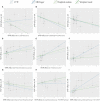Anorexia nervosa and bulimia nervosa: a Mendelian randomization study of gut microbiota
- PMID: 38784806
- PMCID: PMC11111991
- DOI: 10.3389/fmicb.2024.1396932
Anorexia nervosa and bulimia nervosa: a Mendelian randomization study of gut microbiota
Abstract
Background: Anorexia nervosa (AN) and bulimia nervosa (BN) poses a significant challenge to global public health. Despite extensive research, conclusive evidence regarding the association between gut microbes and the risk of AN and BN remains elusive. Mendelian randomization (MR) methods offer a promising avenue for elucidating potential causal relationships.
Materials and methods: Genome-wide association studies (GWAS) datasets of AN and BN were retrieved from the OpenGWAS database for analysis. Independent single nucleotide polymorphisms closely associated with 196 gut bacterial taxa from the MiBioGen consortium were identified as instrumental variables. MR analysis was conducted utilizing R software, with outlier exclusion performed using the MR-PRESSO method. Causal effect estimation was undertaken employing four methods, including Inverse variance weighted. Sensitivity analysis, heterogeneity analysis, horizontal multivariate analysis, and assessment of causal directionality were carried out to assess the robustness of the findings.
Results: A total of 196 bacterial taxa spanning six taxonomic levels were subjected to analysis. Nine taxa demonstrating potential causal relationships with AN were identified. Among these, five taxa, including Peptostreptococcaceae, were implicated as exerting a causal effect on AN risk, while four taxa, including Gammaproteobacteria, were associated with a reduced risk of AN. Similarly, nine taxa exhibiting potential causal relationships with BN were identified. Of these, six taxa, including Clostridiales, were identified as risk factors for increased BN risk, while three taxa, including Oxalobacteraceae, were deemed protective factors. Lachnospiraceae emerged as a common influence on both AN and BN, albeit with opposing effects. No evidence of heterogeneity or horizontal pleiotropy was detected for significant estimates.
Conclusion: Through MR analysis, we revealed the potential causal role of 18 intestinal bacterial taxa in AN and BN, including Lachnospiraceae. It provides new insights into the mechanistic basis and intervention targets of gut microbiota-mediated AN and BN.
Keywords: Mendelian randomization analysis; anorexia nervosa; bulimia nervosa; eating disorders; gut microbiota.
Copyright © 2024 Yu, Guo, Yu, Wang, Yan and Gao.
Conflict of interest statement
MG was employed by Yabao Pharmaceutical Group Co., Ltd. The remaining authors declare that the research was conducted in the absence of any commercial or financial relationships that could be construed as a potential conflict of interest.
Figures



Similar articles
-
Causal effects of gut microbiota on the risk of chronic kidney disease: a Mendelian randomization study.Front Cell Infect Microbiol. 2023 Mar 31;13:1142140. doi: 10.3389/fcimb.2023.1142140. eCollection 2023. Front Cell Infect Microbiol. 2023. PMID: 37065213 Free PMC article.
-
Causal relationship between gut microbiota and tuberculosis: a bidirectional two-sample Mendelian randomization analysis.Respir Res. 2024 Jan 4;25(1):16. doi: 10.1186/s12931-023-02652-7. Respir Res. 2024. PMID: 38178098 Free PMC article.
-
Causal effects of gut microbiota on erectile dysfunction: a two-sample Mendelian randomization study.Front Microbiol. 2023 Oct 19;14:1257114. doi: 10.3389/fmicb.2023.1257114. eCollection 2023. Front Microbiol. 2023. PMID: 37928685 Free PMC article.
-
Exploring the potential causal relationship between gut microbiota and heart failure: A two-sample mendelian randomization study combined with the geo database.Curr Probl Cardiol. 2024 Feb;49(2):102235. doi: 10.1016/j.cpcardiol.2023.102235. Epub 2023 Nov 30. Curr Probl Cardiol. 2024. PMID: 38040216 Review.
-
Causal relationship between gut microbiota and polycystic ovary syndrome: a literature review and Mendelian randomization study.Front Endocrinol (Lausanne). 2024 Feb 1;15:1280983. doi: 10.3389/fendo.2024.1280983. eCollection 2024. Front Endocrinol (Lausanne). 2024. PMID: 38362275 Free PMC article. Review.
Cited by
-
Gut Microbiota in Women with Eating Disorders: A New Frontier in Pathophysiology and Treatment.Nutrients. 2025 Jul 14;17(14):2316. doi: 10.3390/nu17142316. Nutrients. 2025. PMID: 40732941 Free PMC article. Review.
References
-
- Alexander J. L., Mullish B. H., Danckert N. P., Liu Z., Olbei M. L., Saifuddin A., et al. . (2023). The gut microbiota and metabolome are associated with diminished Covid-19 vaccine-induced antibody responses in immunosuppressed inflammatory bowel disease patients. EBioMedicine 88:104430. doi: 10.1016/j.ebiom.2022.104430, PMID: - DOI - PMC - PubMed
-
- AlHadi A. N., Almeharish A., Bilal L., Al-Habeeb A., Al-Subaie A., Naseem M. T., et al. . (2022). The prevalence and correlates of bulimia nervosa, binge-eating disorder, and anorexia nervosa: the Saudi National Mental Health Survey. Int. J. Eat. Disord. 55, 1541–1552. doi: 10.1002/eat.23790, PMID: - DOI - PubMed
-
- Arias D. M., Ortíz-Sánchez E., Okoye P. U., Rodríguez-Rangel H., Balbuena Ortega A., Longoria A., et al. . (2021). A review on cyanobacteria cultivation for carbohydrate-based biofuels: cultivation aspects, polysaccharides accumulation strategies, and biofuels production scenarios. Sci. Total Environ. 794:148636. doi: 10.1016/j.scitotenv.2021.148636, PMID: - DOI - PubMed
LinkOut - more resources
Full Text Sources

